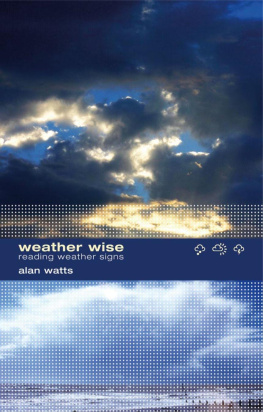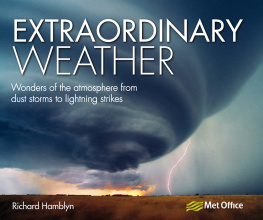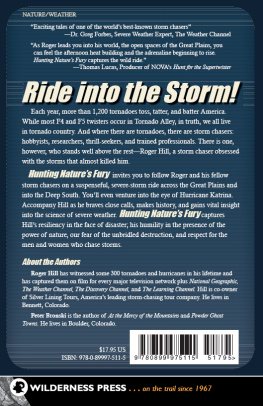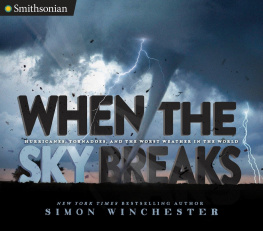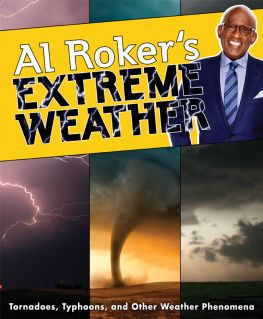Bizarre
Weather
Howling Winds, Pouring Rain, Blazing Heat,
Freezing Cold, Hurricanes, Earthquakes, Tsunamis,
Tornadoes, and More of Natures Fury
JOANNE OSULLIVAN

Text copyright 2012 by Joanne OSullivan.
Illustrations copyright 2012 by Charlesbridge Publishing, Inc.
All rights reserved, including the right of reproduction in whole or in part in any form. Charlesbridge and colophon are registered trademarks of Charlesbridge Publishing, Inc.
An Imagine Book
Published by Charlesbridge Publishing
85 Main Street, Watertown, MA 02472
(617) 926-0329
www.charlesbridge.com
Library of Congress Cataloging-in-Publication Data
OSullivan, Joanne.
Bizarre weather : howling winds, pouring rain, blazing heat, freezing cold, huge hurricanes, violent earthquakes, tsunamis, tornadoes and more of natures fury / Joanne OSullivan; illustrated by Jeff Albrecht.
p. cm. (An imagine book)
Includes bibliographical references.
ISBN 978-1-936140-72-5 (alk. paper)
ISBN 978-1-60734-536-7 (ebook)
ISBN 978-1-60734-659-3 (ebook pdf)
1. Climatic extremesJuvenile literature. 2. StormsJuvenile literature. 3. DroughtsJuvenile literature. 4. Natural disastersJuvenile literature. I. Albrecht, Jeff, ill. II. Title.
QC981.8.C53O88 2012
551.55dc23
2012016236
Cover and interior design by Cindy LaBreacht. Illustrations by Jeff Albrecht.
Printed in China, August 2012
The publisher does not have any control over and does not assume any responsibility for author or third-party websites or their content.
2 4 6 8 10 9 7 5 3 1
ISBN 13: 978-1-936140-72-5
For information about custom editions, special sales, premium, and corporate purchases, please contact Charlesbridge Publishing at
Contents
Introduction
O n a clear day in April 2011, a group of kids met up to play soccer after school at Galashiels Academy in Scotland. They had just started warming up when they heard strange thudding sounds. Alerted by the unusual noise, their gym teacher looked around and noticed that there were worms writhing around on the ground near the students. Then the kids started to cover their heads. The worms were falling from the skymore and more of them with each passing second. The incident lasted just a few minutes, but when it was over, hundreds of worms had dropped to the playing field and onto the tennis court, according to the teacher, who collected some of the worms as samples. The playing field wasnt close to any buildings on campus, eliminating the possibility that the group had fallen victim to a prank. That left just one possibility: this soccer team had just experienced some bizarre weather.
Horses are carried aloft by tornadoes and set down unharmed. Hailstones as big as elephants plummet to the earth. There are whirling columns of fire, clouds created by airplanes, and places where lightning rarely stops flashing. Into the furthest reaches of recorded history, there are stories of strange and unbelievable weather, which was at the time chalked up to witchcraft, devilry, and the end of the world. (When the sky turned pitch black in the middle of the day, surely the end was near!). Our ancestors had no way of knowing that those dark days were just the result of ash particles from raging forest fires or volcanoes mixed with a thick fog.
As technology and forecasting have improved, scientists have been able to offer explanations for some of the most puzzling mysteries in weather history. On the other hand, there are phenomena that still cant quite be explained. And technology can help us uncover even more baffling phenomena, such as high-atmosphere, colored lightning and cloud systems that rain in unison.
Theres nothing like the weather to remind us all that we live in a world thats not always predictable and rational. No matter how much we believe we have conquered nature, it will still have a lot of surprises in store for us. Even in the twenty-first century, a dust storm can shut down a major port city, black rain can pour from the sky, and cities in warm climates can be buried in ice. And, yes, schoolchildren can be pelted with worms.
Forget what you think you know about the weather. The stories in this book will shock, surprise, amuse, horrify, and puzzle you. Collected from historic records, present-day news stories, and research studies, these accounts of bizarre weather capture the volatile and changeable nature of everyones favorite topic. While you may start out a skeptic, youll find that bizarre weather does happen, even if hasnt happened to youyet. Somewhere in the world, at this moment, the rain may be red, the wind vicious, and the temperatures unbearable. Expect the unexpected, and keep your eyes peeled for airborne invertebrates.
Peculiar Precipitation
M ost of us never experience anything more out of the ordinary than a particularly heavy downpour or perhaps a snowstorm big enough to send everyone out to the grocery store for bread and milk. While unexpected, these weather events dont fall into the realm of the mysterious or truly bizarre. But when the rain starts changing colors or things fall from the sky that have no business being in the sky in the first place, it really gets our attention. Frogsor even what appears to be blooddropping from the clouds are the stuff of legend and biblical prophecy. Surely theyre portents of doom or maybe even the end of the world. After all, when the end comes, it seems were all expecting it to come from above. In reality, theres usually a perfectly scientific explanation for these strange occurrences. And when theres not, scientists will continue to search for one.
RAINY DAY BLUES (AND REDS, BLACKS, AND YELLOWS)
The color of raindrops isnt always crystal clear. While there dont seem to be any stories featuring rain in shades of gray, youll find that explanations about the causes and sources of colored rain can often be ambiguous.
RED RAIN
As early as Roman times there have been reports of blood rain. This red-tinted rain has often been interpreted as an omen or sign of the gods displeasure. In fact, most recorded blood rains have been in Europe and are the result of sand and dirt particles from the Sahara Desert being borne up into clouds and redistributed in raindrops.
Charles Darwin wrote about a red rain that he experienced while at sea off the Cape Verde Islands. Darwin estimated that the rain extended for an area of 1,600 miles and reached a distance of up to 1,000 miles off the African coast.
In 1827, there were reports of blood rain falling near the village of Buliavino, Russia. Farmers reported that after the rainstorm, the fields of the village turned orange and then blackened as if covered by soot. Later, residents claimed that their vegetables had grown far beyond their normal size, and people of the village were healthier than ever before. Some who had saved the rain in jars started using it as an elixir for vitality or began selling it as such.
In 1860 in Siena, Italy, a red rain lasted for two hours, and then was followed by two more red rainfalls the same evening. Just a few days later, there was another red rain. When it started, observers said, the rain looked like watered-down red wine. By the time of the last shower, there was only a slight reddish tint to the rain.




